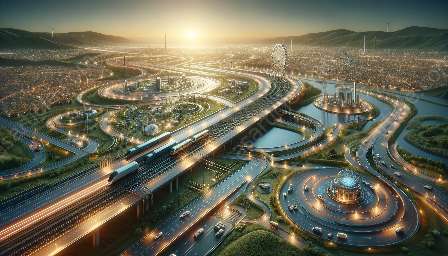Mass transit systems play a crucial role in urban transportation, providing efficient and sustainable options for moving people within cities. With a focus on reducing environmental impact, improving energy efficiency, and addressing urban congestion, sustainability is a key consideration in the design, operation, and maintenance of mass transit systems.
The Role of Sustainability in Mass Transit
Sustainability in mass transit systems encompasses a range of strategies and practices aimed at minimizing the environmental footprint of public transportation while maximizing its benefits to society and the economy. From infrastructure design to operational policies, sustainability considerations are fundamental to the advancement of mass transit engineering and transport engineering.
Sustainable Infrastructure Design
One of the primary areas where sustainability principles are applied in mass transit engineering is in the design and construction of infrastructure. This includes the development of sustainable transit hubs, such as stations and terminals, that integrate energy-efficient technologies, renewable energy sources, and environmentally friendly materials. By applying sustainable design principles, mass transit systems can minimize their environmental impact while creating more pleasant and functional spaces for passengers.
Energy Efficiency and Emissions Reduction
Transport engineering plays a vital role in improving the energy efficiency of mass transit systems and reducing their carbon footprint. This involves the adoption of alternative fuels, electrification of transit vehicles, and the implementation of energy-saving technologies, such as regenerative braking systems and lightweight materials. Additionally, sustainable urban transportation planning focuses on reducing emissions and improving air quality through the promotion of public transit and the integration of sustainable mobility solutions.
Integration of Sustainable Technologies
Advancements in sustainable technologies, such as electric buses, hydrogen fuel cells, and renewable energy systems, are revolutionizing the field of mass transit engineering. These technologies offer innovative solutions for reducing the environmental impact of public transportation while enhancing the overall reliability and performance of transit systems. Integrating these sustainable technologies into mass transit operations represents a pivotal step toward achieving a greener and more efficient urban transportation network.
Challenges and Opportunities in Sustainable Mass Transit
While the integration of sustainability into mass transit systems presents numerous benefits, it also comes with its own set of challenges and opportunities. Addressing these challenges requires a multidisciplinary approach that combines mass transit engineering, transport engineering, and urban planning to create holistic and sustainable solutions for public transportation.
Infrastructure Modernization and Retrofitting
One of the primary challenges in sustainable mass transit is the modernization and retrofitting of existing infrastructure to meet sustainability standards. This involves upgrading aging transit facilities, incorporating energy-efficient technologies, and implementing sustainable transportation management practices. While these initiatives require substantial investment and strategic planning, they present an opportunity to enhance the long-term sustainability and resilience of mass transit systems.
Behavioral Change and User Experience
Encouraging behavioral change and improving the user experience are essential aspects of promoting sustainable mass transit. This includes enhancing accessibility, comfort, and convenience for transit users, as well as implementing measures to incentivize the use of public transportation over private vehicles. By focusing on user-centric design and customer satisfaction, sustainable mass transit initiatives can attract more riders and contribute to reducing traffic congestion and carbon emissions.
Policy and Governance Frameworks
The development of comprehensive policy and governance frameworks is critical for integrating sustainability into mass transit systems. This involves establishing clear sustainability goals, implementing regulatory measures, and fostering partnerships between public and private stakeholders to drive sustainable innovation in transit operations. By aligning policy objectives with engineering expertise, mass transit systems can navigate the complex landscape of sustainable urban transportation and realize their potential as environmentally responsible and economically viable transportation solutions.
The Future of Sustainable Urban Transportation
The future of sustainable mass transit holds tremendous promise for reshaping the urban transportation landscape and creating more livable and resilient cities. Through the convergence of mass transit engineering and transport engineering, sustainable solutions are poised to drive innovation and transformation in public transportation, setting new standards for efficiency, environmental stewardship, and social equity.
Smart and Connected Transit Systems
The integration of smart technologies and connected transit systems represents a pivotal trend in sustainable mass transit. By leveraging data analytics, IoT sensors, and real-time monitoring, transit operators can optimize route planning, enhance operational efficiency, and improve passenger experiences. These advancements enable mass transit systems to adapt to changing demand patterns, minimize energy consumption, and offer personalized, on-demand transportation services.
Multimodal Integration and Seamless Connectivity
Sustainable urban transportation emphasizes the seamless integration of different modes of transit, including buses, trains, light rail, and micro-mobility options such as bicycles and electric scooters. By promoting multimodal connectivity, mass transit systems can offer holistic transportation solutions that cater to diverse travel needs, reduce reliance on single-occupancy vehicles, and enhance overall accessibility and mobility for urban dwellers.
Resilient and Climate-Adaptive Infrastructure
Climate change resilience is a critical consideration in the sustainable design of mass transit systems. As cities face increasing risks from extreme weather events and rising sea levels, transit infrastructure must be designed to withstand environmental challenges and contribute to climate adaptation efforts. Sustainable engineering practices, such as green infrastructure design, flood-resistant facilities, and disaster preparedness planning, are essential for ensuring the long-term viability and resilience of urban mass transit networks.
Conclusion
In conclusion, sustainability is a driving force in reshaping the future of mass transit systems, influencing the way transportation engineering and urban planning intersect to create more sustainable, efficient, and equitable public transportation solutions. As mass transit systems evolve to meet the demands of growing urban populations and environmental challenges, the integration of sustainability principles becomes increasingly essential for establishing resilient, low-impact, and high-performing transit networks that benefit cities and communities worldwide.

